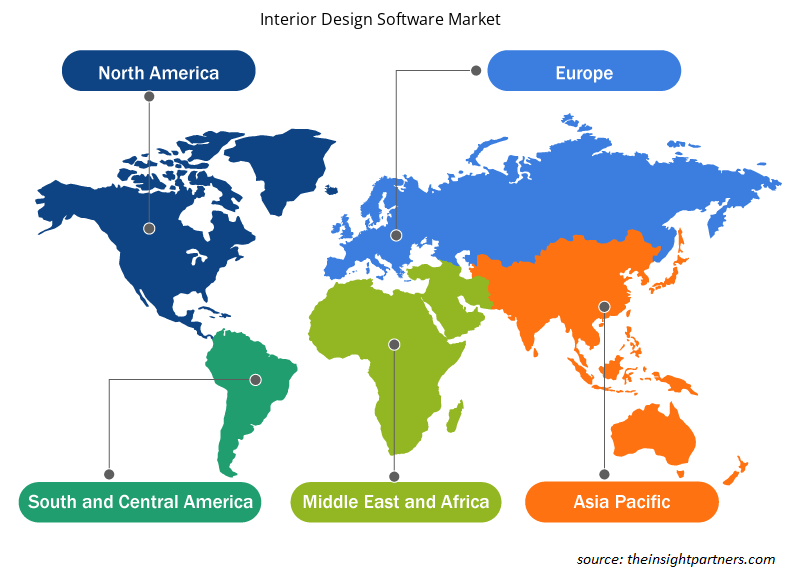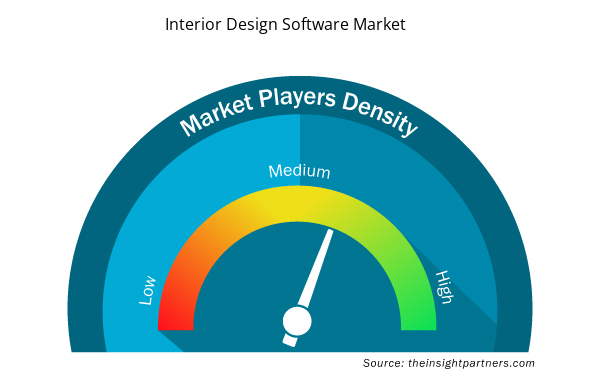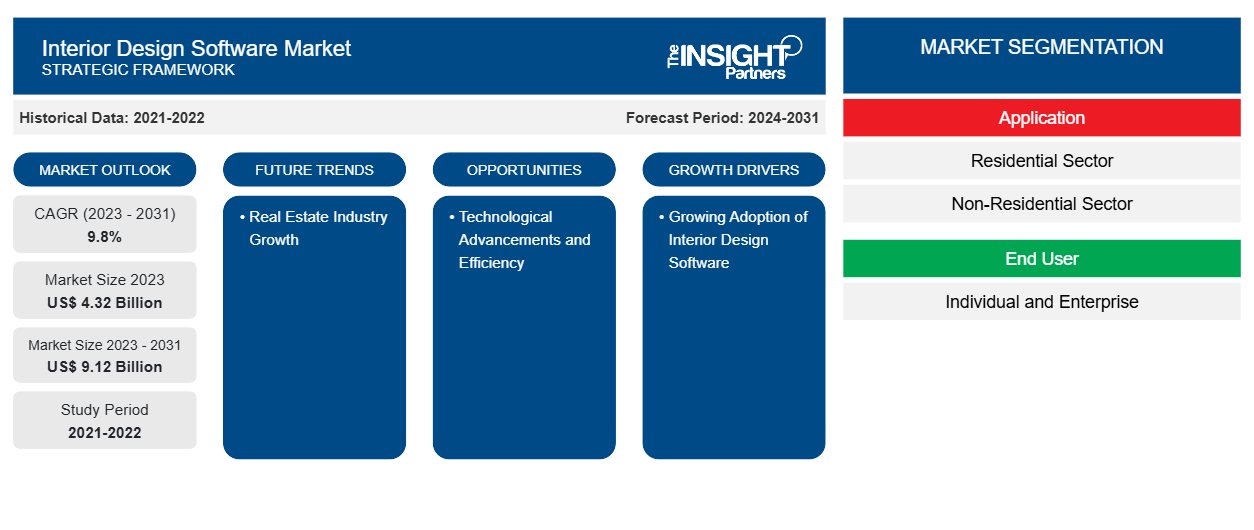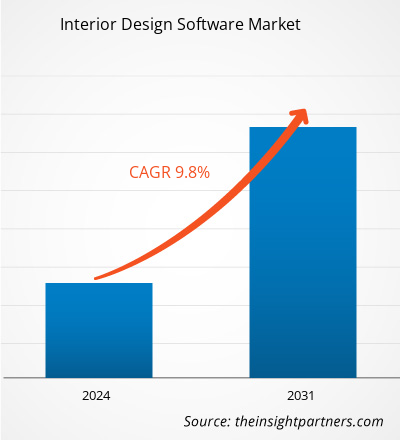Si prevede che la dimensione del mercato del software di interior design raggiungerà i 9,12 miliardi di dollari entro il 2031, rispetto ai 4,32 miliardi di dollari del 2023. Si prevede che il mercato registrerà un CAGR del 9,8% nel periodo 2023-2031. È probabile che la crescita del settore immobiliare rimanga una tendenza chiave nel mercato.
Analisi di mercato del software di interior design
La crescente domanda di maggiore produttività è uno dei principali fattori che guidano questo mercato. Inoltre, la crescente domanda di un migliore design e decorazione degli interni e il crescente utilizzo di software basati su cloud stimolano la crescita del mercato. I problemi di interoperabilità associati al software di interior design limitano la crescita di questo mercato. Inoltre, si prevede che la crescita del processo di virtualizzazione e la domanda di software di interior design, che sta crescendo a un ritmo rapido in paesi come la Cina, forniranno molteplici opportunità al mercato.
Panoramica del mercato del software di interior design
Il software di interior design consente agli architetti di effettuare una stima anticipata della qualità dell'ambiente interno. Gli architetti possono anche utilizzare questo software per identificare, tracciare e misurare qualsiasi deviazione dell'edificio progettato dai criteri richiesti. Questo software consente inoltre agli architetti di adottare misure preventive per ridurre la necessità di ristrutturazione e ricostruzione. Ha anche una raccolta completa di opzioni, come progetti per finestre , porte, letti e tavoli, che un progettista può utilizzare per creare un modello esatto della stanza.
Personalizza questo report in base alle tue esigenze
Riceverai la personalizzazione gratuita di qualsiasi report, comprese parti di questo report, o analisi a livello nazionale, pacchetto dati Excel, oltre a usufruire di grandi offerte e sconti per start-up e università
- Scopri le principali tendenze di mercato in questo rapporto.Questo campione GRATUITO includerà analisi di dati che spaziano dalle tendenze di mercato alle stime e alle previsioni.
Driver e opportunità del mercato del software di interior design
Crescente adozione di software di interior design
Un fattore chiave di crescita per il mercato del software di interior design è il crescente utilizzo di tale software da parte di architetti, ingegneri e appaltatori. Ha contribuito in modo significativo durante le prime fasi di progettazione per la valutazione degli interni. Riduce gli errori, consente una gestione efficace del tempo e mostra eventuali differenze tra un progetto proposto e la costruzione effettiva, migliorando l'efficienza complessiva e l'accuratezza del suo lavoro impostando planimetrie, mobili e decorazioni interne in un ambiente realistico e tridimensionale.
Progressi tecnologici ed efficienza
L'improvviso aumento delle attività di costruzione globali, che si è verificato contemporaneamente all'ampia adozione di software di interior design per apportare miglioramenti nell'efficienza operativa, accelera notevolmente la crescita nel settore dei servizi di interior design. Questa tendenza è ulteriormente rafforzata dalla capacità di questo software di accelerare il processo di progettazione, risparmiare tempo e costi e offrire un'ampia raccolta di scelte di arredamento che consentono ai designer di realizzare modelli di stanze accurati e realistici. Pertanto, la crescente integrazione del software di interior design non solo semplifica le operazioni, ma contribuisce anche alla crescita assoluta del mercato.
Analisi della segmentazione del rapporto di mercato del software di interior design
I segmenti chiave che hanno contribuito alla derivazione dell'analisi di mercato del software di interior design sono le applicazioni e gli utenti finali.
- In base all'applicazione, il mercato è diviso in settore residenziale e settore non residenziale. Il segmento del settore residenziale ha detenuto una quota di mercato significativa nel 2023.
- In base agli utenti finali, il mercato è segmentato in individuale e aziendale. Il segmento aziendale ha detenuto una quota di mercato significativa nel 2023.
Analisi della quota di mercato del software di interior design per area geografica
L'ambito geografico del rapporto sul mercato del software per l'interior design è suddiviso principalmente in cinque regioni: Nord America, Asia Pacifico, Europa, Medio Oriente e Africa, Sud e Centro America.
La panoramica regionale del mercato del software di interior design rivela significative opportunità di crescita in varie regioni. Nell'Asia-Pacifico, l'aumento della popolazione e dell'urbanizzazione, in particolare nelle principali città come Tokyo, Pechino e Mumbai, ha portato a una maggiore attenzione ai settori residenziali, con iniziative come la strategia di sviluppo nazionale della Cina che mira a un'urbanizzazione sostanziale. Inoltre, si prevede che l'Asia-Pacifico registrerà il CAGR più elevato nel mercato durante il periodo di previsione, attribuito all'aumento dei piani infrastrutturali edilizi in paesi come Cina e India, nonché alla crescente urbanizzazione e all'espansione della popolazione nelle principali città come Pechino, Tokyo e Mumbai.CAGR in the market during the forecast period, attributed to increasing
Approfondimenti regionali sul mercato del software di interior design
Le tendenze regionali e i fattori che influenzano il mercato del software di interior design durante il periodo di previsione sono stati ampiamente spiegati dagli analisti di Insight Partners. Questa sezione discute anche i segmenti e la geografia del mercato del software di interior design in Nord America, Europa, Asia Pacifico, Medio Oriente e Africa e America meridionale e centrale.

- Ottieni i dati specifici regionali per il mercato del software di interior design
Ambito del rapporto di mercato del software di interior design
| Attributo del report | Dettagli |
|---|---|
| Dimensioni del mercato nel 2023 | 4,32 miliardi di dollari USA |
| Dimensioni del mercato entro il 2031 | 9,12 miliardi di dollari USA |
| CAGR globale (2023-2031) | 9,8% |
| Dati storici | 2021-2022 |
| Periodo di previsione | 2024-2031 |
| Segmenti coperti | Per applicazione
|
| Regioni e Paesi coperti | America del Nord
|
| Leader di mercato e profili aziendali chiave |
|
Densità dei player del mercato del software di interior design: comprendere il suo impatto sulle dinamiche aziendali
Il mercato del software di interior design sta crescendo rapidamente, spinto dalla crescente domanda degli utenti finali dovuta a fattori quali l'evoluzione delle preferenze dei consumatori, i progressi tecnologici e una maggiore consapevolezza dei vantaggi del prodotto. Con l'aumento della domanda, le aziende stanno ampliando le loro offerte, innovando per soddisfare le esigenze dei consumatori e capitalizzando sulle tendenze emergenti, il che alimenta ulteriormente la crescita del mercato.
La densità degli operatori di mercato si riferisce alla distribuzione di aziende o società che operano in un particolare mercato o settore. Indica quanti concorrenti (operatori di mercato) sono presenti in un dato spazio di mercato in relazione alle sue dimensioni o al valore di mercato totale.
Le principali aziende che operano nel mercato del software per l'interior design sono:
- Autodesk Inc.
- Architetto capo, Inc.
- Dassault Systèmes
- ECDESIGN Svezia AB
- RoomSketcher come
- Unità organizzativa Roomtodo
Disclaimer : le aziende elencate sopra non sono classificate secondo un ordine particolare.

- Ottieni una panoramica dei principali attori del mercato dei software di interior design
Notizie e sviluppi recenti sul mercato del software di interior design
Il mercato del software di interior design viene valutato raccogliendo dati qualitativi e quantitativi post-ricerca primaria e secondaria, che includono importanti pubblicazioni aziendali, dati associativi e database. Di seguito sono elencati alcuni degli sviluppi nel mercato del software di interior design:
- IKEA US ha annunciato il lancio di IKEA Interior Design Service, un nuovissimo programma che offre un interior design professionale e personalizzato a un prezzo accessibile. Consumatori e aziende avranno l'opportunità di mettersi in contatto con un esperto per progettare qualsiasi spazio con soluzioni creative.
(Fonte: Inter IKEA Systems BV, sito web aziendale, aprile 2023)
- Ingka Group, il più grande rivenditore IKEA, lancia oggi la sua nuova esperienza di progettazione digitale basata sull'intelligenza artificiale, IKEA Kreativ. La nuova esperienza intuitiva offre ai clienti il primo modo realistico e completamente integrato per progettare e visualizzare i propri spazi abitativi da computer e smartphone.
(Fonte: Inter IKEA Systems BV, sito web aziendale, luglio 2022)
Copertura e risultati del rapporto sul mercato del software di interior design
Il rapporto "Dimensioni e previsioni del mercato del software di interior design (2021-2031)" fornisce un'analisi dettagliata del mercato che copre le seguenti aree:
- Dimensioni e previsioni del mercato del software di interior design a livello globale, regionale e nazionale per tutti i segmenti di mercato chiave coperti dall'ambito
- Tendenze del mercato del software di interior design, nonché dinamiche di mercato come driver, restrizioni e opportunità chiave
- Analisi dettagliata delle cinque forze PEST/Porter e SWOT
- Analisi di mercato del software di interior design che copre le principali tendenze del mercato, il quadro globale e regionale, i principali attori, le normative e i recenti sviluppi del mercato
- Analisi del panorama industriale e della concorrenza che copre la concentrazione del mercato, l'analisi della mappa di calore, i principali attori e gli sviluppi recenti nel mercato del software di interior design
- Profili aziendali dettagliati
- Analisi storica (2 anni), anno base, previsione (7 anni) con CAGR
- Analisi PEST e SWOT
- Valore/volume delle dimensioni del mercato - Globale, regionale, nazionale
- Industria e panorama competitivo
- Set di dati Excel


- Batter and Breader Premixes Market
- Railway Braking System Market
- Truck Refrigeration Market
- HVAC Sensors Market
- Aesthetic Medical Devices Market
- Photo Printing Market
- Single-Use Negative Pressure Wound Therapy Devices Market
- Enteral Nutrition Market
- Blood Collection Devices Market
- Electronic Data Interchange Market

Report Coverage
Revenue forecast, Company Analysis, Industry landscape, Growth factors, and Trends

Segment Covered
This text is related
to segments covered.

Regional Scope
North America, Europe, Asia Pacific, Middle East & Africa, South & Central America

Country Scope
This text is related
to country scope.
Domande frequenti
The market is projected to record a CAGR of 9.8% during 2023–2031.
The market is expected to reach a value of US$ 9.12 billion by 2031.
Autodesk Inc., Chief Architect, Inc., Dassault Systemes, ECDESIGN Sweden AB, RoomSketcher AS, Roomtodo OU, SmartDraw LLC, Asynth, Foyr, and Planner 5D are key players in the market.
Real estate industry growth is a key trend in the market.
The growing adoption of interior design software is driving the market.
Trends and growth analysis reports related to Technology, Media and Telecommunications : READ MORE..
The Insight Partners performs research in 4 major stages: Data Collection & Secondary Research, Primary Research, Data Analysis and Data Triangulation & Final Review.
- Data Collection and Secondary Research:
As a market research and consulting firm operating from a decade, we have published and advised several client across the globe. First step for any study will start with an assessment of currently available data and insights from existing reports. Further, historical and current market information is collected from Investor Presentations, Annual Reports, SEC Filings, etc., and other information related to company’s performance and market positioning are gathered from Paid Databases (Factiva, Hoovers, and Reuters) and various other publications available in public domain.
Several associations trade associates, technical forums, institutes, societies and organization are accessed to gain technical as well as market related insights through their publications such as research papers, blogs and press releases related to the studies are referred to get cues about the market. Further, white papers, journals, magazines, and other news articles published in last 3 years are scrutinized and analyzed to understand the current market trends.
- Primary Research:
The primarily interview analysis comprise of data obtained from industry participants interview and answers to survey questions gathered by in-house primary team.
For primary research, interviews are conducted with industry experts/CEOs/Marketing Managers/VPs/Subject Matter Experts from both demand and supply side to get a 360-degree view of the market. The primary team conducts several interviews based on the complexity of the markets to understand the various market trends and dynamics which makes research more credible and precise.
A typical research interview fulfils the following functions:
- Provides first-hand information on the market size, market trends, growth trends, competitive landscape, and outlook
- Validates and strengthens in-house secondary research findings
- Develops the analysis team’s expertise and market understanding
Primary research involves email interactions and telephone interviews for each market, category, segment, and sub-segment across geographies. The participants who typically take part in such a process include, but are not limited to:
- Industry participants: VPs, business development managers, market intelligence managers and national sales managers
- Outside experts: Valuation experts, research analysts and key opinion leaders specializing in the electronics and semiconductor industry.
Below is the breakup of our primary respondents by company, designation, and region:

Once we receive the confirmation from primary research sources or primary respondents, we finalize the base year market estimation and forecast the data as per the macroeconomic and microeconomic factors assessed during data collection.
- Data Analysis:
Once data is validated through both secondary as well as primary respondents, we finalize the market estimations by hypothesis formulation and factor analysis at regional and country level.
- Macro-Economic Factor Analysis:
We analyse macroeconomic indicators such the gross domestic product (GDP), increase in the demand for goods and services across industries, technological advancement, regional economic growth, governmental policies, the influence of COVID-19, PEST analysis, and other aspects. This analysis aids in setting benchmarks for various nations/regions and approximating market splits. Additionally, the general trend of the aforementioned components aid in determining the market's development possibilities.
- Country Level Data:
Various factors that are especially aligned to the country are taken into account to determine the market size for a certain area and country, including the presence of vendors, such as headquarters and offices, the country's GDP, demand patterns, and industry growth. To comprehend the market dynamics for the nation, a number of growth variables, inhibitors, application areas, and current market trends are researched. The aforementioned elements aid in determining the country's overall market's growth potential.
- Company Profile:
The “Table of Contents” is formulated by listing and analyzing more than 25 - 30 companies operating in the market ecosystem across geographies. However, we profile only 10 companies as a standard practice in our syndicate reports. These 10 companies comprise leading, emerging, and regional players. Nonetheless, our analysis is not restricted to the 10 listed companies, we also analyze other companies present in the market to develop a holistic view and understand the prevailing trends. The “Company Profiles” section in the report covers key facts, business description, products & services, financial information, SWOT analysis, and key developments. The financial information presented is extracted from the annual reports and official documents of the publicly listed companies. Upon collecting the information for the sections of respective companies, we verify them via various primary sources and then compile the data in respective company profiles. The company level information helps us in deriving the base number as well as in forecasting the market size.
- Developing Base Number:
Aggregation of sales statistics (2020-2022) and macro-economic factor, and other secondary and primary research insights are utilized to arrive at base number and related market shares for 2022. The data gaps are identified in this step and relevant market data is analyzed, collected from paid primary interviews or databases. On finalizing the base year market size, forecasts are developed on the basis of macro-economic, industry and market growth factors and company level analysis.
- Data Triangulation and Final Review:
The market findings and base year market size calculations are validated from supply as well as demand side. Demand side validations are based on macro-economic factor analysis and benchmarks for respective regions and countries. In case of supply side validations, revenues of major companies are estimated (in case not available) based on industry benchmark, approximate number of employees, product portfolio, and primary interviews revenues are gathered. Further revenue from target product/service segment is assessed to avoid overshooting of market statistics. In case of heavy deviations between supply and demand side values, all thes steps are repeated to achieve synchronization.
We follow an iterative model, wherein we share our research findings with Subject Matter Experts (SME’s) and Key Opinion Leaders (KOLs) until consensus view of the market is not formulated – this model negates any drastic deviation in the opinions of experts. Only validated and universally acceptable research findings are quoted in our reports.
We have important check points that we use to validate our research findings – which we call – data triangulation, where we validate the information, we generate from secondary sources with primary interviews and then we re-validate with our internal data bases and Subject matter experts. This comprehensive model enables us to deliver high quality, reliable data in shortest possible time.


 Ottieni un campione gratuito per questo repot
Ottieni un campione gratuito per questo repot